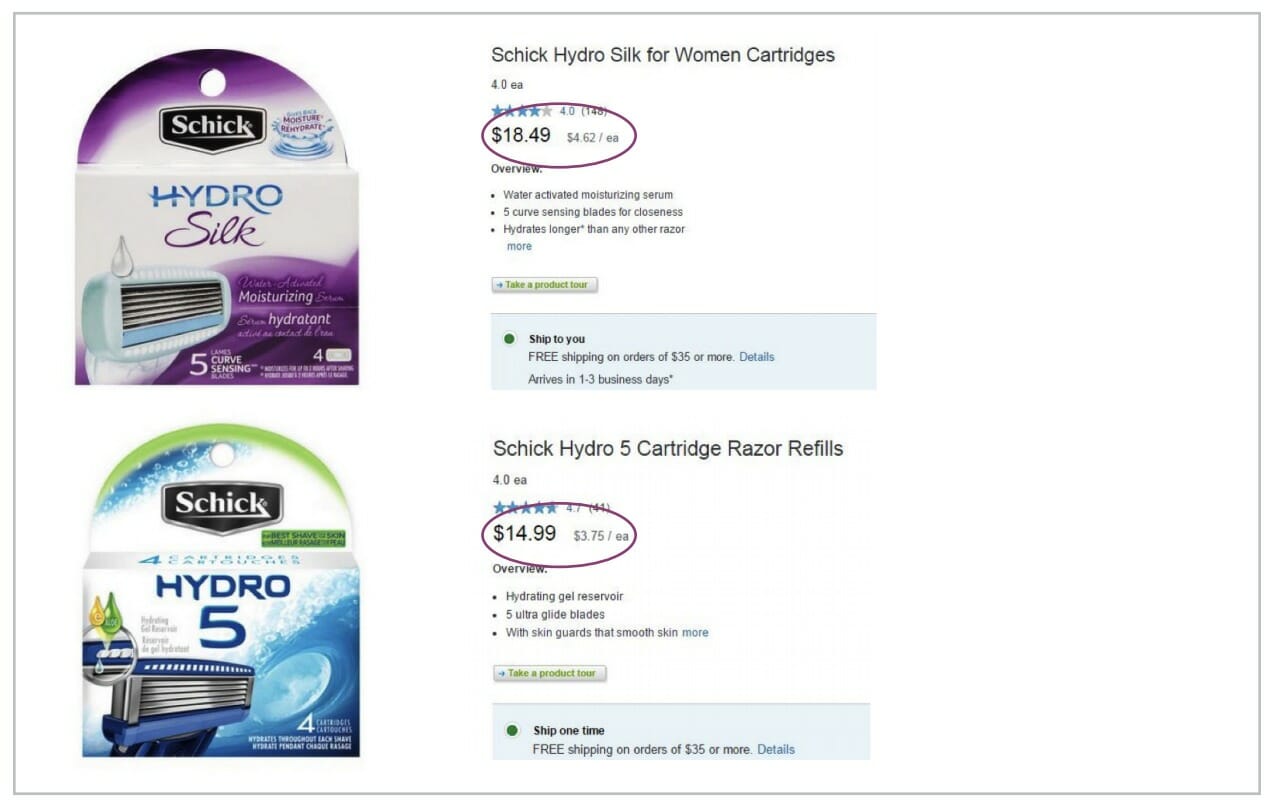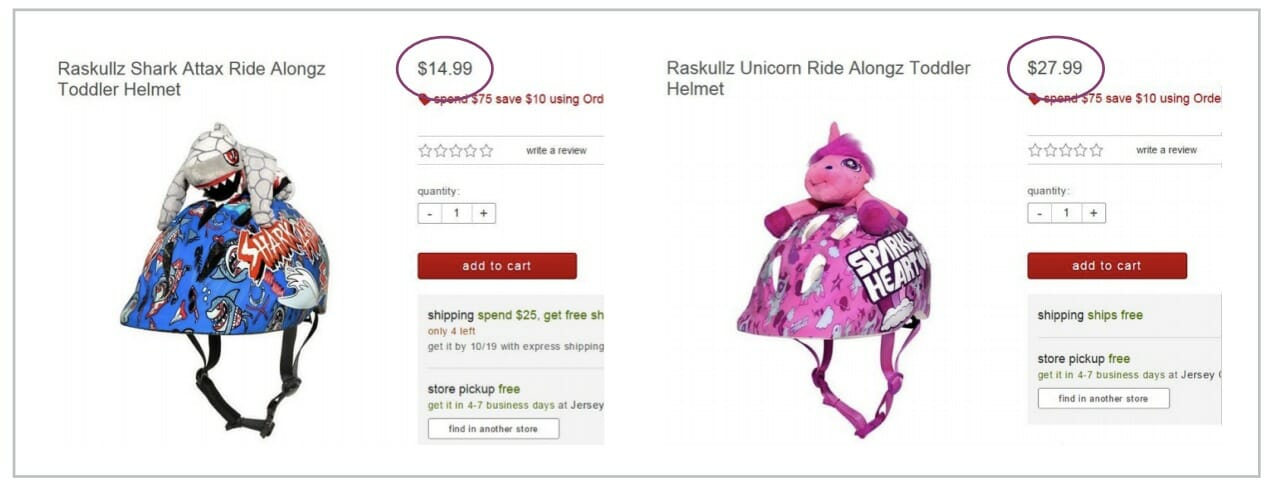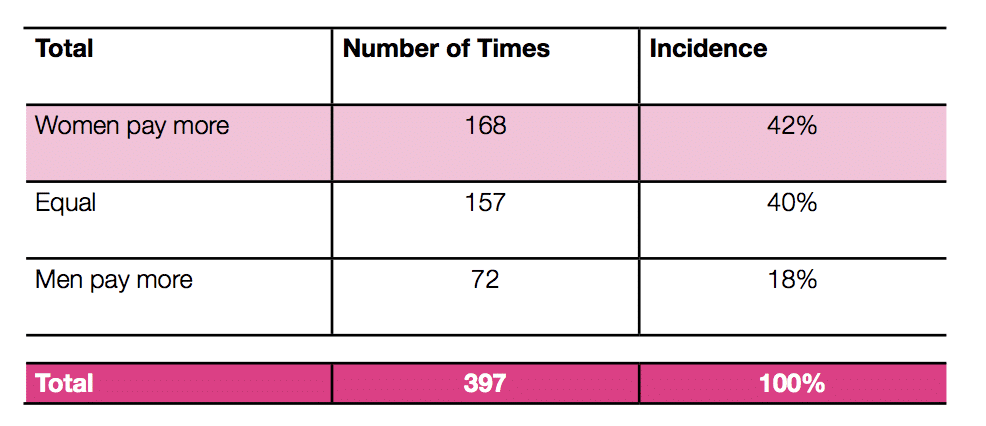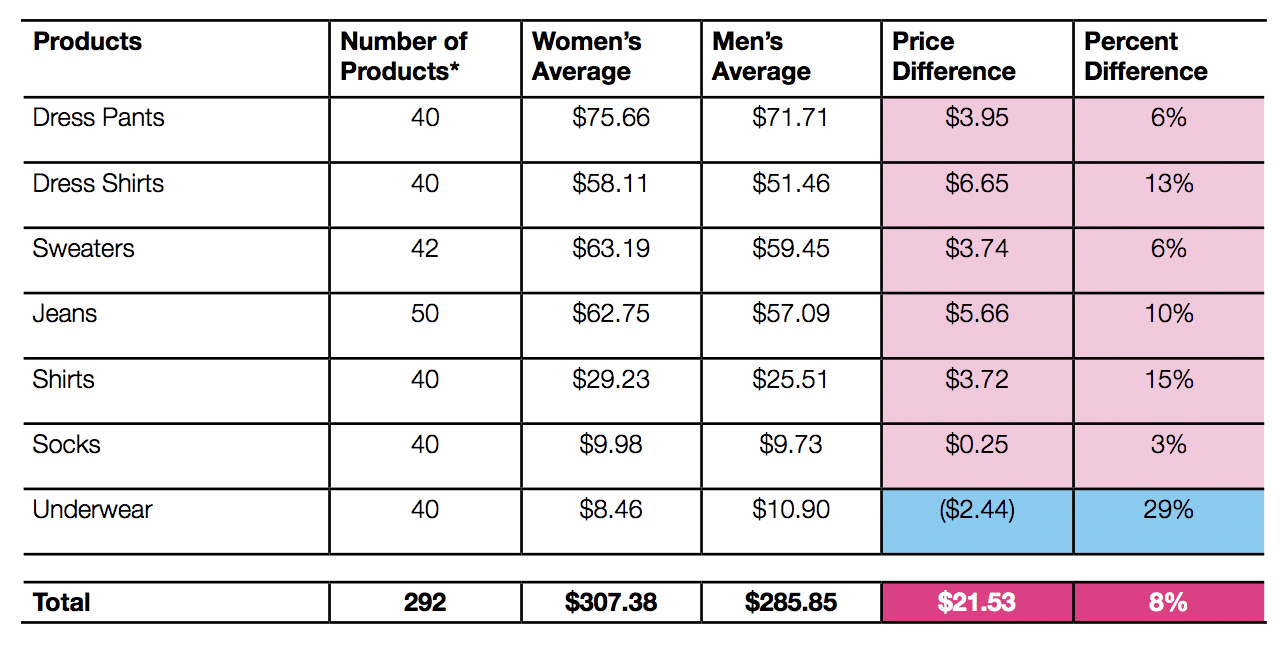If you aren’t sure if you’re paying the pink tax, answer a few questions. Are you a woman? Do you buy women’s feminine hygiene products, women’s clothing, razors, and body wash? If you answered “Yes” to any of those questions, you are indeed paying the pink tax.
The pink tax is only about half of the population is subject to. And they probably aren’t even aware of it. Do you know the cost of being a female consumer?
Most of us have probably heard of the wage gap, that men earn more than women. Typically you’ll see that women make just $0.79 for every $1 a man makes. This is true, but it doesn’t tell the whole story. There is also
price discrimination.
What often gets lost in translation is what the uncontrolled wage gap represents: women are less likely to hold high-level, high-paying jobs than men… This is what we call the opportunity gap.
It goes on…
The controlled gender pay gap, which controls for a number of factors so that the only differentiation between workers is their gender, shrunk by just $0.008 since 2015. Women now make $0.98 for every dollar an equivalent man makes.
So things are not as bad as you might have thought. But even if women are making almost what men make, we’re still paying more for similar products and services.
What Is the Pink Tax?
The pink tax refers to the extra amount of money women pay for specific products or services. Sometimes you’ll see or hear it referred to as gender discrimination or gender-pricing.
Frequently, especially when it comes to personal care products, there is no difference between the male and the female versions apart from different prices.
The classic example is those cheap razors for sale in most drug stores: no fancy moisturizing strip, no rust-free titanium, just a single blade.
The gender-specific “men’s” version is blue, the “women’s” version is pink. That’s the only difference, the color. But inevitably, the women’s version is more expensive than the men’s product.
But examples abound, and plenty of them cost women more than a few cents in the drug store.
Pink Tax Statistics
There has been a lot of research on the pink tax that found overall; women were paying more than men 42% of the time.
How much more? About $1,300 more a year in extra costs. That’s $1,300 that can’t go into a women’s retirement fund.
And don’t forget, women live longer than men, so we need that retirement money!
The New York City Department of Consumer Affairs released a study comparing the prices of over 800 products. The study’s goal was to estimate the price differences male and female shoppers face when buying the same types of items.
The results: Products for women and girls cost 7% more than comparable products for men and boys.
- 7% more for toys and accessories
- 4% more for children’s clothing
- 8% more for adult clothing
- 13% more for personal care products
- 8% more for senior/home health care products
When Was the Pink Tax Introduced?
Women being charged a higher cost for things isn’t new. The sales tax system in the United States was created decades ago.
Politicians had to decide which products would be subject to a sales tax and which would be tax-free. But things have changed since these decisions came about, and tax policies have not changed to reflect the times.
Like women’s clothing, some things have higher tariffs when imported from abroad than do men’s clothing.
Manufacturers of consumer goods like those razors claim that the cost of product design and marketing for women’s products costs more, and they pass those costs down to female consumers.
Pink Tax Examples
It’s pretty hard to avoid the gender tax when it’s applied to things all of us have to buy or pay for. Here are just a few things women are paying more for.
Clothes
Old Navy got busted for charging more for women’s plus-size clothing but not for men’s. For example, the plus-sized women’s jeans were $12-15 more than the standard-sized ones.
But there was no such difference between the prices of men’s plus and regular-sized jeans.
Gap, who owns Old Navy, released a statement that the additional cost was because “they are created by a team of designers who are experts in creating the most flattering and on-trend plus styles, which includes curve-enhancing and curve-flattering elements such as four-way stretch materials and contoured waistbands, which most men’s garments do not include.”
The words “flattering and on-trend” aren’t exactly ones that spring to mind when I think of Old Navy. Instead, cheaply made and ready for the rag bag after a couple of washes are what I believe.
Women’s clothing cost more than men’s in six of seven categories, except underwear, which cost an average of 29% more for men.
The clothing product category that had the most significant price difference by percent was women’s shirts, which cost 15% more than men’s shirts.
Dry Cleaning
Dry cleaners are another place women will pay more for the same service. Men’s shirts cost an average of $2.86 for dry cleaning, and women’s cost $4.95.
But a woman’s dress shirt doesn’t require any different dry cleaning technique than a man’s shirt.
Self Care Products
These are the kinds of things you buy in a drug store, razors, shaving cream, deodorant, face cleansers. These kinds of products are prime offenders when charging women more for the “pink” products.
Here’s what you can do, ladies, buy the men’s stuff!
Unless you purchase the fancy razors with multiple blades and “moisture strips,” the only difference between generic old stick razors for men and women is that our’s are pink, and theirs are blue.
Surprisingly, color has little effect on the hair removal process.

And buy a big old can of Barbasol. The stuff has been around since 1919 for a reason. It lasts forever, works excellent, and whatever you’re shaving won’t smell like the inside of a raspberry pop tart.
You’re not out of the drug store yet. If you have internal rather than external plumbing, you will spend about $3,000 throughout your life on tampons and other feminine hygiene products.
Jessica Valenti wrote a piece in the Guardian last year wondering why these products weren’t accessible or at least not taxed.
The backlash was swift and vitriolic. You would have thought she had the nerve to say that insurance shouldn’t cover Viagra!
The tampon tax has its niche in the gender tax world, and for good reason.
While women can avoid paying the pink tax in some cases by choosing the male version of something, there is no option when it comes to menstrual products.
Toys
Unfortunately, the pink tax is from cradle to cane. Across the six product categories of toys, the girls’ items were consistently more expensive than ones for boys.
The most significant price discrepancy was in helmets and knee/elbow pads.
The girls were priced a whopping 13% higher. But, of course, if you buy things for children, you probably already know of the price disparity.

Some of these companies take the “pink” in pink tax very seriously. Similarly, a pink kid’s beginner bike from Target.com was $80, while the non-pink version was $64.
Boomerang Commerce studied 50 popular kids’ products at six online retailers, including Target, Amazon, Walmart, Macy’s, JCPenney, and Bloomingdales.
They analyzed items in various colors, and every time, the pink-colored thing was the most expensive. Compared to other colors, Pink items ranged from 2-15% more.
Vehicle Repair
I think this one is an old cliche, but it’s true. Northwestern did a study that had men and women call various repair shops asking about the cost of having a radiator replaced.
Women who seemed clueless on the phone were quoted $406 for a job that should cost $365. Men who acted similarly uninformed were quoted $383.
The NYC Department of Consumer Affairs study found that when women bought used cars, they were twice as likely to have been quoted a higher price than men.
It pays to do enough research before making these inquiries about having a ballpark figure of what you should expect to pay.
And that goes for both sexes, no matter what they are paying for. People will take advantage of uninformed consumers no matter what their gender.
This is our guide to budgeting simply and effectively. We walk you through exactly how to use Mint, what your budget should be, and how to monitor your spending automatically.
How Do You Avoid the Pink Tax?
Did you know tampons and pads are subject to sales tax because they are considered “luxury” items? Periods are certainly not a luxury, and I’m sure every woman would agree.
Recently, some companies have been stepping against unfair pricing and moving towards high-quality ultra-low-cost prices. Harry’s is one of them.
Harry’s sells shaving products and other excellent skincare products that are the cheapest you can find without compromising on quality. Yes, finally, an affordable shave club that works for women.
Harry's provides low-priced, quality grooming products including body wash and bar soap, face care, shampoos, and razors. Their social mission sets aside 1% of its sales for donations to charitable organizations like CALM and Headstrong to foster mental well-being.
Billie offers a similar service.
Boxed is another company fighting the good fight. They’re Rethinking Pink and standing up to the pink tax.
Boxed is enforcing price equality for women on a per ounce or per unit basis for products that typically cost more for women than men. And my favorite, no taxation for tampons.
The best way to avoid this is to buy the men’s version of certain products, do some homework, and shop for the best prices on things like dry cleaning.
Or do what one women’s rights group did in France. They started a site and uploaded photos of products that had unequal pricing.
Publicly shaming companies sometimes have a positive impact. For example, putting them on blast through Twitter will often garner faster results than writing letters and signing petitions.
New media is like a megaphone. It amplifies your ability to reach more people.
Tweet ThisPink Tax Legislation
As a country, we are making some progress on gender equality issues. For example, under the Affordable Care Act, insurance companies can no longer charge women more for similar services. Insurers must also cover birth control, which is more human right than Viagra.
In 1996, Governor Wilson of California created the Gender Tax Repeal Act requiring merchants to charge women and men the same price if a service took the same time, cost, and skill to provide. It was aimed at services such as haircuts, dry cleaning, car repairs, and other services—but not at products.
In 2018, Democratic Representative Jackie Speier introduced the Pink Tax Repeal Act intended to:
…prohibit the pricing of consumer products and services that are substantially similar if such products or services are priced differently based on the gender of the individuals for whose use the products are intended or marketed or for whom the services are performed or offered.
The bill failed. In 2019, lawmakers in 22 states introduced bills that would repeal the tampon tax, but none went into law. However, other countries are making more progress.
Around the world, Canada, India, Malaysia, and Australia have nixed the tax, and Britain is on track to do so once Brexit negotiations are settled.
Sorry to deliver more bad news, ladies. If you are aware of stuff like this, you can avoid it. Tax day is unavoidable (unless you’re in the 1%), but you can sometimes prevent the Pink Tax if you know how to spot it.




